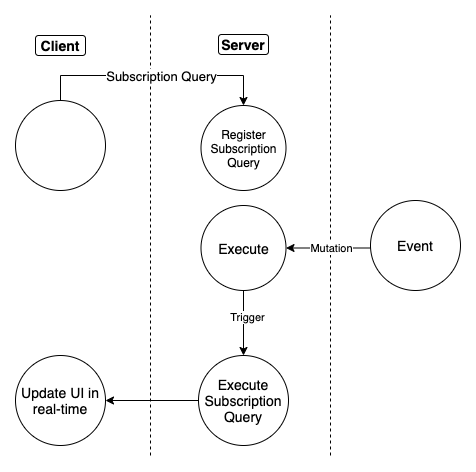We’re overhauling Dgraph’s docs to make them clearer and more approachable. If
you notice any issues during this transition or have suggestions, please
let us know.

Enable subscriptions in GraphQL
In GraphQL, it’s straightforward to enable subscriptions on any type. You can add the@withSubscription directive to the schema as part of the type
definition, as in the following example:
@withSubscription with @auth
You can use @auth access control rules
in conjunction with @withSubscription.
Consider following Schema that has both the @withSubscription and @auth
directives defined on type Todo.
X-Dgraph-AuthToken header
and uses the USER claim to apply a Role-based Access Control (RBAC). The
authorization rule enforces that only to-do tasks owned by $USER are returned.
WebSocket client
Dgraph uses the WebSocket protocolsubscription-transport-ws.
Clients must be instantiated using the WebSocket URL of the GraphQL API which is
your
Dgraph GraphQL endpoint
with https replaced by wss.
If your Dgraph endpoint is https://<path> the WebSocket URL is wss://<path>
If your GraphQL API is configured to expect a JWT token in a header, you must
configure the WebSocket client to pass the token. Additionally, the subscription
terminates when the JWT expires.
Here are some examples of frontend clients setup.
Urql client setup in a React app
In this scenario, we’re using the urql client andsubscriptions-transport-ws modules.
In order to use a GraphQL subscription query in a component, you need to
- instantiate a
subscriptionClient - instantiate a urql client with a
subscriptionExchangeusing theubscriptionClient
process.env.REACT_APP_DGRAPH_ENDPOINTis your Dgraph GraphQL endpointprocess.env.REACT_APP_DGRAPH_WSSis the WebSocket URLprops.tokenis the JWT token of the logged-in user.
fetchOptions and
in the WebSocket client using connectionParams.
Assuming we use graphql-codegen, we can define a subscription query:
messages.data.queryTodo to
display the updated list of to dos.
Apollo client setup
To learn about using subscriptions with Apollo client, see a blog post on GraphQL Subscriptions with Apollo client. To pass the user JWT token in the Apollo client,useconnectionParams, as
follows.
Dgraph.Authorization configuration of your
GraphQL schema.
Subscriptions to custom DQL
You can also apply@withSubscription directive to custom DQL queries by
specifying @withSubscription on individual DQL queries in type Query, and
those queries are added to type subscription.
For example, see the custom DQL query queryUserTweetCounts below:
queryUserTweetCounts is added to the subscription type, allowing users to
subscribe to this query.
Currently, Dgraph only supports subscriptions on custom DQL queries. You
can’t subscribe to custom HTTP queries.
Starting in release v21.03, Dgraph supports compression for subscriptions.
Dgraph uses
permessage-deflate compression if the GraphQL client’s
Sec-Websocket-Extensions request header includes permessage-deflate, as
follows: Sec-WebSocket-Extensions: permessage-deflate.
